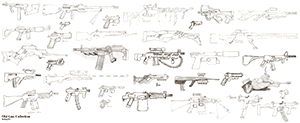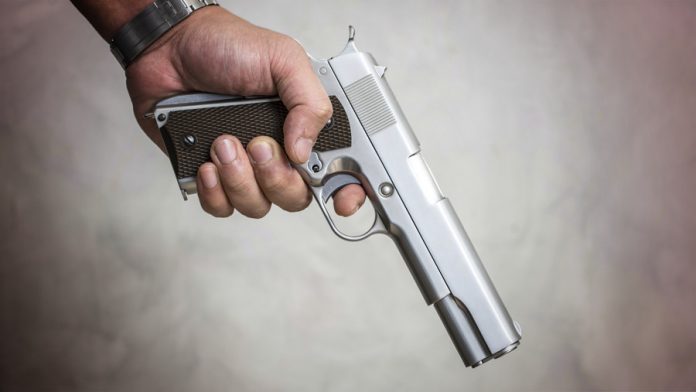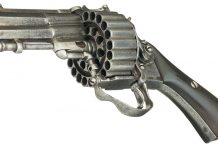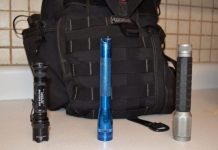Joe the New Prepper has a pretty good plan in place for his family to collect water, food, medical supplies, toiletries and other essentials so in the event of an accident that prevents “business as normal.” Over time, by careful observation, it happens to him that, besides the noisy Chihuahua and a well-used softball bat, he has no provision for protecting his family and property, which reminds him mainly how much more athletic he was before he turned 40.
Invariably he knows that even the odds are the best way for him to acquire a gun. Or two. But Joe has no experience with firearms and he runs quickly face-to-face into the myriad of details, choices, calibers, manufacturers, styles, accessories and on and on.
Daunted, Joe gets closer to his neighbor Dennis, who Joe knows has at least a few guns. A half hour of conversation with Dennis leaves Joe more confused … Dennis talked to him like he knew something about everything he-Joe-knew little to nothing about. An hour of perusing a few online forums helped Joe get even more confused. “This is the best, that’s the best, you need one of these, you don’t even need one” … too much conflicting knowledge left Joe feeling a little more than hopeless. So Joe wanted to climb into the car, find some weapons stores. At the first, Joe got the blank “idiot” stare-like “if you don’t already know this, it is beneath me to explain it”. The guy at the next store answered Joe’s questions with the question “How much money have ya got?” In a half a day’s time Joe felt like he’d heard more, and actually knew less than he ever did about defensive firearms. Poor Joe.
Let’s cut to the chase. Point by point.
1. What’s the best handgun for defensive purposes?
The best handgun for defensive purposes is a combat worthy (this is key) handgun that fires a bullet that you can well manage for rapid follow up shots that fits your hand. It has to be accurate, robust and “combat accurate” Accurate fighting is capable of grouping 4 inches to 25 yards. A combat worthy semi-auto is likely to run you from a minimum of $550 to $600, and easily up that. When any large military or police force is given a firearm it is certainly worth fighting. The argument is that the weapon was designed and tested to withstand thousands of rounds of fire in less than optimal conditions, with limited stoppages (jams). You’ll find someone easily swearing that their $200-300 handgun “goes bang every time”. But the question remains “Is the weapon such that I can trust my loved ones’ protection to it?


A defensive handgun is usually going to be a semi-auto due to the quick reload capability, but in the hands of a well-trained shooter there’s nothing wrong with a professional revolver. Nevertheless, it takes well trained fingers to reload a revolver (with speed-loaders) approaching a semi-auto ‘s pace.
A pistol is a decent man-stopper because it is thin, and fires a medium-to-heavy bullet at medium speeds. It is not a main line defensive weapon, but they are handy to carry, and serve as a great backup in a true, self defense emergency.
There are different calibers and the things to bear in mind-how comfortable/manageable is shooting, particularly for follow up shots? How is the Ammunition available? For my money .22 LR, 9 mm, .40 SW, .45 ACP and .38/.357 mag are the only reasonable options if I have to “forage” for ammunition some day, how likely it is I would find this caliber. They are accessible, common and (with the exception of the .22) they all have an appropriate level of stopping power. Stopping power is a function of the weight of the bullet and the velocity of the projectile, and is generally expressed in foot/lbs of energy, which will normally be noted on the factory-made ammunition box. There are plenty more calibers out there, they’re just not passing all the tests. Some are too strong to handle effectively in a defensive scenario; some are too small to be effective; some are unlikely to be forage-able at all.
2. How many magazines should I have?
You should have at least three spare mags for each handgun at a minimum, and twice that is ideal. In a protracted WROL, mags will eventually break, wear out, get lost. For magazine fed defensive rifles, 10 mags per weapon is a good minumum.
Related: 15 Best Guns for Preppers
3. Should I rotate my magazine(s)?
(That is to unload the magazine periodically to “rest” it).
NO. Steel springs have a fatigue limit, like all steel, and compression/decompression is what causes the spring to fatigue. Ideally, one has a limited collection of “target mags” that are used on a daily basis, and other mags that simply remain filled, and a few more that remain in the package and will not be filled before replacements are available. Spare mag followers and springs will help restore good working order to old mags, so it’s not a bad idea to get some of those after you’ve completed your other preps.
4. If I get a semi auto defensive rifle what kind should I get?


First of all, a rifle is a much better defense platform than a handgun as it avoids concerns surrounding power and magazine size, so a rifle is kind of a must in my opinion. Just like handguns, a weapon capable of combat is practically mandatory. There are some cheap options out there but my question, again, is “is this a tool to which I can trust the protection of my family?” That said, a $600 weapon is better than none when resources are minimal. Things to look for in a defensive rifle – the barrel metallurgy – “cold hammer forged”, “chrome lined ” are good places to start. It ensures longer life in the barrel. For a protective rifle-barrel, one thing I prefer to avoid is stainless steel. You don’t want the extra glare, and some manufacturers will use a less costly 416 stainless steel due to manufacturing ease (expense) and these items have proved to be less than robust, showy as they are. AR-type weapons and AK-type guns are available and chambered in calibers that are plentiful and likely to be forage-able in a challenging situation. My strategy is to stay away from the hard-to-reach cartridges when times get difficult. A shotgun is also a powerful, close-range defense tool.
5. What kind of accessories do I need for my AR, or other defensive rifle or shotgun?
Number one – you guessed it – plenty of magazines. Then, a sling and a reliable way of attaching it to the rifle. A sling gives you the ability to carry the gun hands free and virtually ready, which helps a lot if you have to: look at a map, forage berries, field dress a rabbit, forage firewood, build a shelter, eat your dinner, etc., etc., etc. Outside there are a bunch of good ones. Be thinking within the range of $50 to $75. Another plus is a flashlight which you can affix to the pistol. A scope can be useful, depending on the ranges in which you are going to work and many people like the red dot or holographic sights. I like the red dot holographic, but the holographic does not actually project light onto the mark, which lets you remain unseen. The main rule is to practice and be able to use the iron sights first, then consider increasing your rifle’s sighting system. Things break, and batteries wear down, so it’s important to be competent with the basics before moving on to the fancy stuff.
There are also boatloads of modifications that can be made to an AR, or other kinds of defensive weapons, and a person can spend a lot of money adding features and equipment to his firearm. My rule is KISS – Keep is Simple Silly. I don’t have an infinite amount of money to spend on unlimited gear. Also, I don’t want to tote around a weapon weighing 10 pounds or more, when I can hold it down to 7 or 8 pounds. Last but not least, and most importantly for me, I almost never increase a weapon with custom features if I believe the features can erode my ability to operate in stock trim with a similar weapon. Which is to say, if I have all the latest and greatest fancy things on my AR and I’m forced to fight with the weapon of my enemy in the course of events, and his weapon is without all the “extras” will I then be handicapped in my ability to operate the weapon? In the words of Chuck Yeager, “It’s the pilot, not the aircraft.” My ability to protect myself and my family will be a feature of my preparation and attitude, and not my weapons. That said, if a person requires an extended charging handle or a specific trigger group due to any disability such as arthritis or missing digits, then that is what it is, and that person should be thankful someone thought up a way to make the weapon functional. Short of that situation, I prefer to ignore a lot of the customization available for the weapons of today.
6. What else do I need?
We’ve covered magazines already so clearly ammunition in abundance. You’ll have to determine how much of your financial capital you want to commit to it, but remember that the ammunition would be as good as cash or better in a very bad situation. For your handguns – another place you will also need holsters to not cheap out. A belt of decent quality. For extra mags, Mag pouches. You can hang a pouch on your belt to put empty magazines inside. A decent kit to clean, spare gun oil and extra solvent to clean. Water safe (such as surplus ammunition cans) containers to store extra ammo in. Spare batteries if you have a flashlight on any of your weapons and/or for your holographic sight. Then extra firing pins, recoil springs, mag springs then supporters, bolt carrier classes, when you round out your preps. Redundancy, baby! And don’t forget training. “If you want to be good at a thing, do it 10,000 times!”
7. How many guns do I need?


“One is none and two is one”. For example, when constructing a battery consider getting two Glocks, or two Sigs, rather than one of each, might be more helpful. Why? Because if one breaks, you can salvage parts from the one to keep the other running. It also minimizes the element of preparation, as you need to be familiar with the fewest possible weapons. Therefore, accept queries. You may need to hunt in order to survive, so a bolt action gun in .308 gives you plenty of flexibility, as well as a shotgun (12 gauge is the order of the day, due to the potential need to forge ammo). .22 calibre handguns and long arms also add a great deal of flexibility to your case. Note just how many people there will be in your group, and how best to meet their defensive abilities and needs.
8. Where can I go for more info?
Find a local gun store that wants your business bad enough to treat you like they do want your business, to answer your questions thoroughly, and to let you handle a variety of weapons to find the type/style/manufacturer that best suits your needs and your price range. If the person at the gun store tries to talk down to you, turn around and leave. You’re going to find someone out there who needs to earn a living. The internet is a wonderful tool too, but sometimes one has to wade through a bunch of nonsense to find the nuggets.
Related: Awesome Places to Hide Your Guns Around The House
Remember – Safety First!
1. Treat every gun as though its loaded at all times.
2. Never put your finger in the trigger guard until you are ready to shoot.
3. Never, ever, point a weapon at anything you are not willing to destroy.
4. Double, then triple check to be sure a weapon is unloaded when handling.
5. Educate your family members on how to safely operate the weapons.
6. Store the weapons properly to be sure that no unattended individuals, especially children, can gain access to the weapons without your supervision.
Get all the training you can. Youtube has tons of videos relating to such.
By no means am I any manner of expert. However, I’ve studied the field carefully and I have more than a couple of decades experience with defensive firearms. While I probably haven’t even scratched the surface of all the questions that come up for someone that is new to firearms, I hope this has been helpful.





















